After logging thousands of flight hours in iconic Howard DGA–15s beginning as a teenager, California rancher Bruce Dickenson developed his own ideas for making the relatively fast and powerful airplanes from the 1930s and 1940s even better.
That is to say, even faster and more powerful.
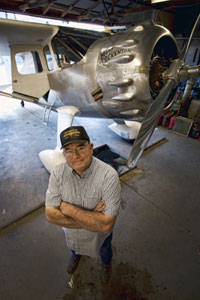 Bruce Dickenson and his masterpiece near Ventura, Calif.
Bruce Dickenson and his masterpiece near Ventura, Calif.
Dickenson knew that more speed and power both were attainable based on the legendary Howard racer, Mr. Mulligan, which set a series of speed records in 1935. But Dickenson wasn’t interested in creating a replica of the high-wing racer. Instead, he sought to combine the roomy interior, comfort, and load-hauling capacity of the DGA–15 with the higher speed, faster rate of climb, greater range, and lighter control forces of the racer.
“I know what’s right about a Howard and what’s wrong,” said Dickenson, who soloed in his father’s DGA–15 at age 17. “The handling qualities could be improved, and so could the speed. I wanted to keep the size and convenience of the DGA–15 and add way more speed. I wanted to create my own version of what I thought a perfect Howard should be.”
Dickenson, 60, has no formal training in aeronautical engineering. But he’s good with his hands after spending a lifetime building and maintaining farm equipment—and he’s got a wealth of practical experience working on airplanes. His dad bought a Howard when Dickenson was 4 years old, and he has assisted with a variety of restoration projects, including a Spartan Executive that his family used to own and fly.
“In addition to working well, my main goal for the exhaust system was that it had to make the engine sound bitchin’.”
Even though the aviation world has increasingly gravitated toward composite materials, smaller and lighter engines, and nosewheels, Dickenson’s ideal airplane was a throwback. His starting point was a steel-tube fuselage with fabric covering, a big radial engine, and a tailwheel. He began making detailed drawings in 1997, and he started welding the frame two years later—on Memorial Day 1999. Aerospace engineers reviewed his plans from time to time, but all the decisions on dimensions, materials, and construction techniques were Dickenson’s alone.
The Experimental airplane that would combine aspects of the DGA–15 and the famous DGA–6 racer became known as the Dickenson-Howard DGA–21 (15 plus 6), and it slowly began taking shape in Dickenson’s crowded, corrugated-metal hangar at Santa Paula Airport in Southern California. There were no blueprints to follow, and no instruction book. Dickenson thought through each step at home, consulted old photographs and other Howard experts, and bought prefabricated parts where he could—all while running a Santa Paula citrus and avocado ranch full time.
The spring aluminum landing gear, for example, came from Grove. The wheel fairings came from Jim Younkin of Springdale, Arkansas—designer and builder of the Mullicoupe—who became an enthusiastic proponent of Dickenson and his airplane when Younkin stopped at Santa Paula on a business trip. The tailwheel assembly came from a wrecked DGA–15, as did the rudder bar and a few other parts. Dickenson simply designed them into the fuselage he was building from scratch.
 The wooden wings got their airfoil and chord dimensions from Mr. Mulligan, and Dickenson built the wings from a spruce spar, birch ribs, and mahogany covering.
The wooden wings got their airfoil and chord dimensions from Mr. Mulligan, and Dickenson built the wings from a spruce spar, birch ribs, and mahogany covering.
“My airplane has a lot of similarities to Mr. Mulligan, but in no way is it a replica,” Dickenson said. “Where I could use better materials and techniques, I did. You’ll see that in the avionics, landing gear, Teflon coating on the control cables, and elsewhere.”
Instead of a 450-horsepower Pratt & Whitney R-985 from the DGA–15, Dickenson went with a larger, 600-horsepower R-1340. It has a 12:1 supercharger and Airflow Performance fuel injection. Dickenson also fabricated his own exhaust system based on parts from a de Havilland Otter. “In addition to working well, my main goal for the exhaust system was that it had to make the engine sound bitchin’,” Dickenson said. “An engine like this ought to have a recognizable sound.”
The thirsty powerplant also meant Dickenson’s airplane would have to carry lots of fuel, and it does—191 gallons. There are five fuel tanks: two in the wings and three in the belly.
When he rolled the airplane out of his hangar to fly for the first time on November 22, 2008, Dickenson had spent more than nine years poring over every detail. Although unpainted, with its nickname, “Mr. Dickenson”—a nod to Mr. Mulligan—crudely hand-drawn on the cowl with a marking pen, the fit and finish were outstanding. Every inch of the airplane, from the compound curves in the metal to the smooth wood surfaces and exact fit of the fiberglass fairings, was flawless. (Dickenson keeps a long mental list of imperfections, but they’re visible only to him.)
His airplane stands at exactly the same 13-degree deck angle as a DGA–15 because that jaunty stance just seemed right to Dickenson, and it’s what he’s accustomed to.

Dozens of well-wishers turned out on a cool, crisp morning to watch the first flight, and that, too, turned out remarkably well. The airplane launched from 2,700-foot Runway 22 at Santa Paula and growled skyward at 3,000 feet per minute. With a sleek chase plane in trail, Dickenson found that his airplane cruised at nearly 200 miles an hour and stalled gently with flaps up or down. The well-balanced handling qualities that he’d sought were there, too.
“This thing’s a complete sweetheart,” the gruff rancher said over the radio to his wife, Janice, who was monitoring the first flight and had supported his obsessive pursuit for a decade. “It’s absolutely everything I wanted it to be.”
In the two years since that first flight, Dickenson has flown the airplane regularly, but he hasn’t taken it to fly-ins or had it competitively judged because, in his mind, it’s not yet ready. It’s still unpainted because the last two years have been abysmal for avocado and citrus farmers, and Dickenson is unwilling to spend more money on the airplane until the farm economy improves.
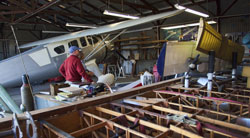 In fact, the cost of the airplane is one piece of data that the usually inquisitive Dickenson says he doesn’t want to know. Janice keeps the books at their household, and she could tell him to the penny how much he has spent, if he asked. So he makes it a point to never ask.
In fact, the cost of the airplane is one piece of data that the usually inquisitive Dickenson says he doesn’t want to know. Janice keeps the books at their household, and she could tell him to the penny how much he has spent, if he asked. So he makes it a point to never ask.
“I don’t know what I spent on this airplane, and I don’t want to know,” Dickenson said. “I’m sure I could have had a Bonanza for what I’ve spent on this airplane. Who knows? I may have been able to have a Baron for what I’ve spent already. But I didn’t want a Baron. I wanted a Howard that goes as fast as a Baron, and now I’ve got one.”
In addition to paint, Dickenson also has yet to add the Garmin GNS420, autopilot, yaw damper, and oxygen system. The airplane is wired and plumbed for them, but the items are on hold. “I’ve deferred those things for purely economic reasons,” he said. “I’ll get them eventually. But the airplane can fly without them—and I really enjoying the flying.”
Abdominal workout
Two things jump out during a preflight inspection of the DGA–21: the superior quality of its workmanship and the audacity of its design.
“Throughout this whole process, I never doubted that I’d get it done, and I never regretted starting it.”
The airplane’s imposing size, muscular frame, hulking engine, gleaming two-blade prop, and impossibly short and thin wings convey refined ferocity. It puts an abundance of speed and power in the pilot’s hands, and it will require skill and proper technique to keep those forces in balance.
The single access door is on the right side of the aircraft behind the strut. You climb aboard via a metal step and walk uphill to the cockpit. Two roomy seats there provide plenty of comfort, but the extreme nose-high attitude and lack of forward visibility make it anything but relaxing. Dickenson flew from the left seat and I observed from the right during two hour-long flights: an aircraft demonstration and then a photo flight.
Engine start is standard, and taxiing in the busy general aviation airport’s tight confines requires constant S-turning. Engine runup is normal, but warming the R-1340’s 10 gallons of oil takes several minutes at relatively high power, and the throaty sound of the short exhaust pipes hints at the maelstrom to come.
Once aligned with the runway, Dickenson smoothly applied full power, and a combination of rapid acceleration and the reclined seating position provided a short but vigorous abdominal workout. It felt like trying to do sit ups with a heavy weight on your chest. At about 40 mph, Dickenson added forward pressure on the steering column to raise the tail, and the airplane lifted off at about 70 mph after a ground roll of about 1,200 feet.
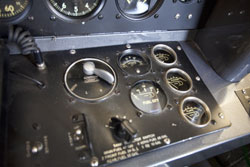 The airplane accelerated to 140 mph at the departure end of the 2,700-foot strip and Dickenson began a shallow left turn in accordance with local procedures to follow the contours of the Santa Clara River. The left turn is for noise abatement, but that term is a bit of a joke with the DGA–21 because its characteristic roar can be heard for miles.
The airplane accelerated to 140 mph at the departure end of the 2,700-foot strip and Dickenson began a shallow left turn in accordance with local procedures to follow the contours of the Santa Clara River. The left turn is for noise abatement, but that term is a bit of a joke with the DGA–21 because its characteristic roar can be heard for miles.
During a 140-mph cruise climb, the DGA–21 gained altitude at more than 1,500 feet per minute, and the full-power fuel consumption rate was a ravenous 58 gallons an hour.
At 5,000 feet, Dickenson reduced the power to 28 inches of manifold pressure and 2,000 rpm, and the airplane settled into an easy 180-mph cruise at 28.5 gph. Pitch trim is controlled via a crank handle on the cockpit ceiling, and the relatively heavy elevator and wide speed range make spinning the trim handle an almost constant task. Control forces are relatively heavy and well balanced, and despite the complete lack of wing dihedral, the airplane has a strong tendency to return to level flight when disturbed.
“It’s not a Pitts so the control forces aren’t light,” Dickenson said. “It’s a very stable airplane in pitch, roll, and yaw, and that’s what I was going for. To me, the control harmony is absolutely delightful.”
Unaccelerated stalls occur at 64 mph with flaps down and 67 mph clean and are preceded by mild airframe buffeting followed by a crisp, wings-level break. Even without a yaw damper, adverse yaw is almost nonexistent at cruise speeds.

In the landing pattern, the 109-inch prop provides a great deal of braking action in the low pitch/high rpm setting, and Dickenson performed wheel landings, with the main gear touching down at about 70 mph. Even without a headwind, moderate braking allowed for stopping in about 1,400 feet of ground roll.
Clarity of purpose
The registration name of this aircraft—the Dickenson/Howard DGA–21—is meant as a tribute to the two airplanes it’s based on. But in combining them, Bruce Dickenson has created something unique and unlikely to be replicated. The airplane is meant to satisfy the uncompromising demands of one idiosyncratic builder and owner, and the fact that it does that so well is quite a testament to Dickenson’s skill, determination, and independent nature.
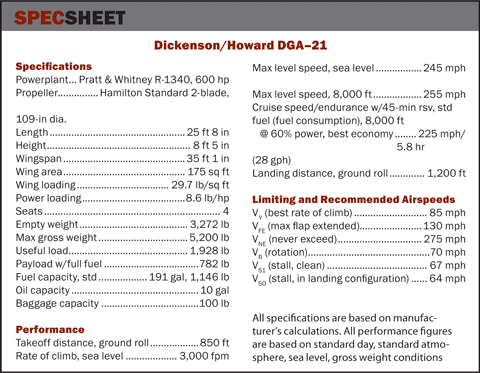
Few pilots possess such well-defined visions of our perfect airplanes. And almost none of us have the talent, will, or resources to translate those ideas into reality. The DGA–21 is remarkable for its boldness, beauty, and complete clarity of purpose. And despite its long and strenuous gestation period, Dickenson said he never doubted that his airplane would ultimately fly, or that it would perform exactly as he had envisioned more than a decade ago.
“This is the only airplane I’ve ever built from scratch,” he said, “and I’m very proud that I could get it to this point where it flies like I wanted it to fly. Throughout this whole process, I never doubted that I’d get it done, and I never regretted starting it. Once I start something, I’m committed.”
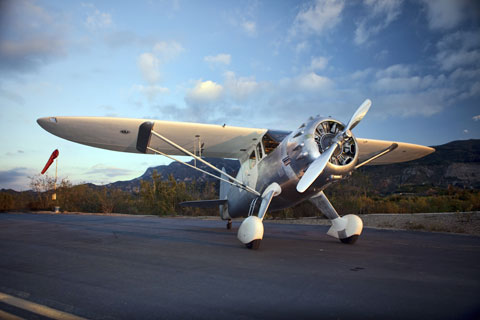
E-mail the author at [email protected].


